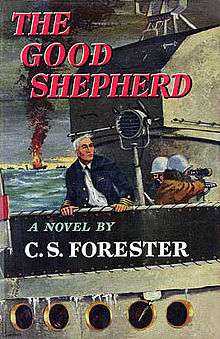The Good Shepherd (novel)
 First US edition cover | |
| Author | C.S. Forester |
|---|---|
| Country | United Kingdom |
| Language | English |
| Genre | Historical novel |
| Publisher |
Michael Joseph (UK) Little, Brown and Co. (US) |
Publication date | 1955 |
| Media type | Hardcover & paperback |
The Good Shepherd (1955) is a nautical and war novel by C.S. Forester, best known as the creator of fictional Royal Navy officer Horatio Hornblower.
Plot summary
The hero of The Good Shepherd is Commander Krause, the captain of the fictional US Navy Mahan-class destroyer USS Keeling in World War II. Krause is in overall command of an escort force protecting an Atlantic convoy in the Battle of the Atlantic. He finds himself in a difficult position. The voyage in question occurs early in 1942, shortly after America's entry into the war. Although he is a career Navy officer, with many years of seniority, this is Krause's first wartime mission. The captains of the other escort vessels are junior to him, and much younger, but they have been at war for over two years.
The story is told in third person entirely from Krause's point of view as he fights his ship, detailing his mood swings from his intense and focused excitement and awareness during combat to his resulting fatigue, depression, and self-doubt as his self-perceived inferiority and inexperience to the other captains under his command troubles him (although as the story progresses he is shown to be quite capable). He broods over his career; his wife left him partly because of his strict devotion to duty. He is troubled when the press of duty forces him to neglect his prayers. (Unlike most of Forester's other heroes, Krause is devout.) And he is troubled by recollections that the Navy review board had twice passed him over for promotion, returning a judgement of fitted and retained due to little or no opportunity in the prewar Navy. His promotion to Commander only came when the United States entered the war, leading him to fear that he may be unsuited to his command.
The book illustrates the difficulties of the Atlantic war: the struggle against the sea, the enemy, and the exhaustion brought on by constant vigilance. It also details the problems of the early radar and ASDIC equipment available and the poor communications between the fleet and Admiralty.